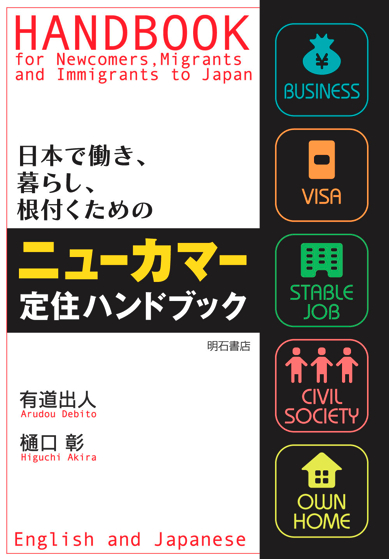mytest






![]()

UPDATES ON TWITTER: arudoudebito
DEBITO.ORG PODCASTS now on iTunes, subscribe free
Hi Blog. The Suraj Case of a mysterious death of a NJ during deportation, despite the system’s best efforts to keep it under wraps (including media underreportage, nobody arrested or charged, an proforma investigation, an inconclusive autopsy, and even workplace punishment of the widow for making a fuss about her husband’s death), continues on with another hunger strike in a different “Gaijin Tank” Immigration Detention facility.
Good article detailing the breadth and depth of the issue came out in the AFP the other day. Have a look. Arudou Debito in Sapporo
/////////////////////////////////////////////////////////
Inmates on hunger strike in Japan immigration centre
By Harumi Ozawa (AFP) – May 20, 2010, Courtesy of Liza’s Twitter Feed
http://www.google.com/hostednews/afp/article/ALeqM5jf1HRDmVvn_yJNlK6g94oQVTwDCg
TOKYO — Scores of foreigners in a Japanese immigration detention centre have been on hunger strike for more than a week, demanding to be released and protesting the mysterious death of an African deportee.
Some 70 detainees — many of them Sri Lankans and Pakistanis — have refused food since May 10, also seeking to highlight suicides there by a Brazilian and a South Korean inmate, say their outside supporters.
The protest comes after UN rights envoy Jorge Bustamante in March raised concerns about Japan’s often years-long detentions of illegal migrants, including parents with children as well as rejected asylum seekers.
“Those in the centre suffer such mental stress from being confined for so long,” said Kimiko Tanaka, a member of a local rights group, about the East Japan Immigration Centre in Ushiku, northeast of Tokyo.
Japan keeps tight control on immigration and last year, despite generous overseas aid for refugees, granted political asylum to just 30 people.
Human rights activists, lawyers and foreign communities have complained for years about conditions at Ushiku and Japan’s two other such facilities, in the western prefecture of Osaka and in southwestern Nagasaki prefecture.
At Ushiku, about 380 people are detained, with eight or nine inmates living in rooms that measure about 20 square metres (215 square feet), said Tanaka, a member of the Ushiku Detention Centre Problem Study Group.
“They are crammed into tiny segmented rooms that are not very clean, and many contract skin diseases,” she told AFP.
The hunger strike protesters said in a statement that “foreigners are the same human beings as Japanese” and claimed that conditions are severe and their freedom to practise their religions is being curtailed.
“The Immigration Bureau has forced asylum seekers to leave voluntarily by confining them for a long time, making them give up on their religion, weakening their will and torturing their body and soul,” they said.
“Japan, a democratic country, must not do such a thing, no matter what.”
The protest erupted weeks after a Ghanaian man, Abubakar Awudu Suraj, died in unexplained circumstances in March as Japanese immigration officials escorted the restrained man onto an aircraft bound for Cairo.
“Police conducted an autopsy but could not find out the cause of his death,” a Narita Airport police spokesman told AFP about the 45-year-old, whose Japanese widow has challenged authorities to explain.
Rights activists believe he was gagged with a towel, recalling a similar but non-fatal case in 2004 when a female Vietnamese deportee was handcuffed, had her mouth sealed with tape and was rolled up in blankets.
The protesters on hunger strike argue two recent suicides by hanging — a 25-year-old Brazilian, and a 47-year-old South Korean — also illustrate Japan’s harsh treatment of inmates.
“Those were very unfortunate incidents,” said an official at the Ushiku immigration centre who declined to be named.
“We recognise the largest problem is that an increasing number of foreigners here refuse to be deported, despite legal orders,” he said.
The official also said the number of asylum seekers had doubled since 2008 mostly because of turmoil in Myanmar and Sri Lanka.
Last year 1,388 people, including 568 Myanmar and 234 Sri Lankan nationals, sought refuge in Japan.
Japan’s immigration authorities have faced protests before. Two months ago, 73 foreigners at the Osaka centre staged a two-week hunger strike.
“We would have seen suicides like in Tokyo if they had waited longer,” said Toru Sekimoto, who leads the local support group TRY, which successfully won the temporary release of most of the protesters.
Hiroka Shoji of Amnesty International Japan said: “The immigration facilities are supposed to be places where authorities keep foreigners for a short period before deportation.
“But some people have been confined for over two years as a result. The government must introduce a limit to detentions.”
A Justice Ministry official who asked not to be named said: “The government will interview protesters at the centre and take appropriate measures.”
ENDS
4 comments on “AFP: Another hunger strike in Immigration Detention Center, this time in Ushiku, Ibaraki”
“Another hunger strike?” I thought this was the same one, just continuing. No?
Sounds horrid. I wonder if they would let media in to see the conditions?
— No no, different place. Last one was in the Kansai. No idea how that came out. Media coverage petered out.
“…recalling a similar but non-fatal case in 2004 when a female Vietnamese deportee was handcuffed, had her mouth sealed with tape and was rolled up in blankets.”
My first reaction to this was, “Dear God, did they actually do that!?” Maybe I’m a little naïve when I say this, but how can a country that prides itself on its civilization and politeness turn a blind eye to such barbaric treatment of another human being?
At any rate, it’s interesting to note that the one official they interviewed quickly found a way to toss the blame to the foreigners because they refuse to be deported. Not a word about inappropriate detention conditions or violations of basic human rights (freedom of religion, etc.) And somehow, the assurance that the Justice Ministry will take ‘appropriate measures’ sounds sinister more than anything.
@Rachel, how would you rather they immobilize her? If she is a danger to herself and others short of a straight jacket or a table with restraints rolling her up in a carpet/blanket is the easiest and most humane way to keep her from injuring herself or others.
The inhumane way would be to just taser her till she stops moving, apply a compliance hold and hope she complies before she expires or is seriously injured (such as the often fatal choke hold), or beat her unconscious.
So yes, I think you are a little naive.
— Either way, whether or not you consider a person naive or a procedure humane, a situation where somebody dies in custody has to be investigated and responsibility taken. A death is not standard procedure.
Jerry, I always like to look for the cause behind the action. In other words, I wonder what drove the woman to become a danger to herself and others, as you said, in the first place. A perceived threat, such as unnecessary force, can make a person lose control. At any rate, they could have used a mild sedative to subdue her rather than physical restraints.
Sorry for derailing the discussion, Debito.